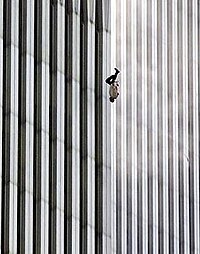The Falling Man
From Wikipedia, the free encyclopedia
"The Falling Man" is a story about a photograph taken by Richard Drew at 9:41:15 a.m., on September 11, 2001 of a man falling from the World Trade Center during the September 11 attacks in New York City. The story, written by Tom Junod, appeared in the September 2003 issue of Esquire magazine, and was later made into a film.
The subject of the image — whose identity remains unknown, although attempts have been made to identify him — was one of the people (dubbed "jumpers" by the press) trapped on the upper floors of the skyscraper that apparently chose to jump rather than die from the fire and smoke. This picture is somewhat deceptive; it gives the impression the man is falling straight down. In reality, this is just one of a dozen photographs of his fall. In the other photos, it is evident that he is tumbling through the air out of control.
The photographer has noted that, in at least two cases, newspaper stories commenting on the image have attracted a barrage of criticism from readers who found the image disturbing.[1]
Contents |
[edit] Possible identity
Because of the number of jumpers, identifying the man captured in the twelve photos was not an easy task. At least 200 people either jumped or fell to their deaths.[2]
Initially, the faller was identified by The Globe and Mail reporter Peter Cheney as Norberto Hernandez, but when the family looked at the whole series of pictures (there were approximately a dozen images), it was clear that it was not Hernandez. Three other families claimed that he was their relative, but after careful analysis of the photo this was disproved.
|
I hope we're not trying to figure out who he is and more figure out who we are through watching that.
—Gwendolyn, 9/11: The Falling Man
|
Five years after the attacks, Jonathan Briley, a 43-year-old employee of the Windows on the World restaurant, was identified by chef Michael Lomonaco as The Falling Man. Briley was a sound engineer who lived in Mount Vernon, New York and worked in the North Tower restaurant. According to the film, the victim was initially identified by his brother in the morgue by the victim's hands and shoes. Lomonaco claims that he was able to identify Briley by his clothes and body-type. In one of the pictures, The Falling Man's clothes were blown away, revealing an orange undershirt similar to the shirt that Briley wore to work almost every day. His older sister, Gwendolyn, asserted he was wearing that shirt on the day of the attack. She told reporters of The Sunday Mirror, "When I first looked at the picture...and I saw it was a man - tall, slim - I said, 'If I didn't know any better, that could be Jonathan.'" A charity has been set up for Briley's family, and many news programs have aired his story as being the one of The Falling Man.[citation needed] However, the identity of The Falling Man has never been officially confirmed.
[edit] Documentary film
9/11: The Falling Man is a 2006 documentary film about the picture and the story behind it. It was made by American filmmaker Henry Singer and filmed by Richard Numeroff, a New York-based director of photography. The film is loosely based on Junod's Esquire story. It also drew its material from photographer Lyle Owerko's pictures of falling people. It debuted on March 16, 2006, on the British television channel Channel 4. It later made its North American premiere on Canada's CBC Newsworld on September 6, 2006, and has been broadcast in over 30 countries. The U.S. premiere was September 10, 2007, on the Discovery Times Channel.
[edit] Use in literature and music
- The picture plays an important part in the book Extremely Loud and Incredibly Close by Jonathan Safran Foer. The last fifteen pages of his text comprise a flip-book collection of images of a similar man shot by photographer Lyle Owerko falling upwards toward the top of the World Trade Center. Although he is not the first to make the claim, Foer demonstrates how the falling man is used as a symbol for grieving families much like the "Tomb of the Unknown Soldier."
- Falling Man, a novel by Don DeLillo, is about the events of 9/11. The Falling Man in the novel refers to a performance artist recreating the events of the picture seen above. DeLillo claims that he was unfamiliar with the title of the picture when he named his book. The artist straps himself into a harness and jumps from an elevated structure in a high visibility area (such as a highway overpass), hanging in the pose of the falling man.
[edit] Notes
- ^ Howe, Peter (2001). "Richard Drew". The Digital Journalist.
- ^ Cauchon, Dennis and Martha Moore (September 2, 2002). "Desperation forced a horrific decision". USATODAY. http://www.usatoday.com/news/sept11/2002-09-02-jumper_x.htm. Retrieved on 2006-09-09.
[edit] References
- 9/11: The Falling Man (March 16, 2006). Channel 4.
- Junod, Tom (September 2003). Falling Man". Esquire.


